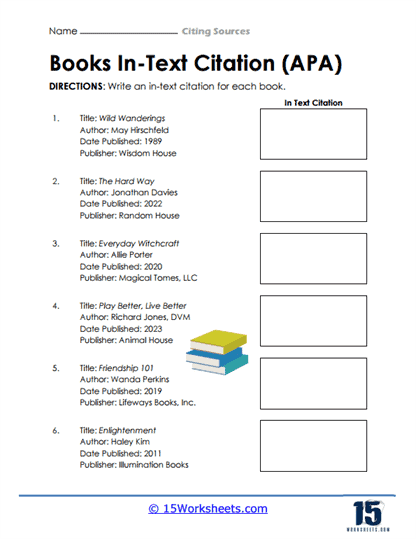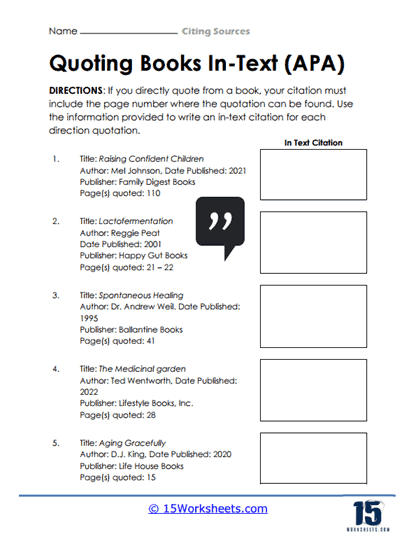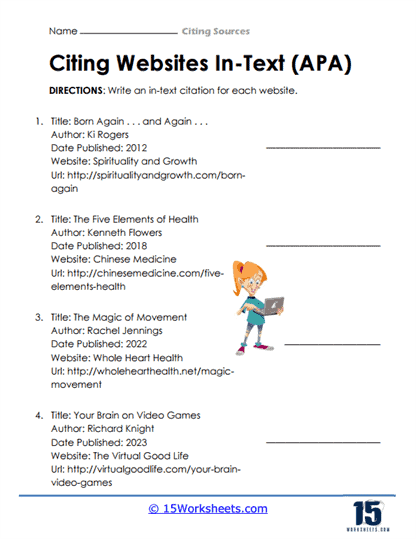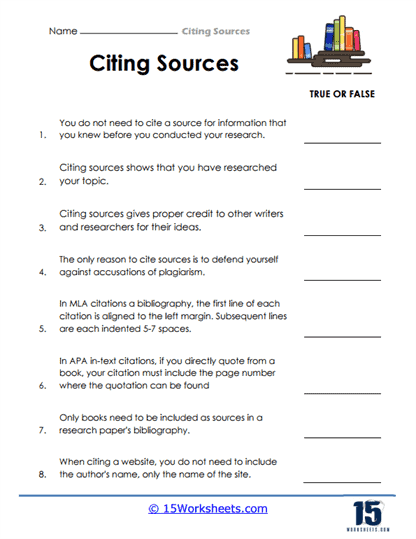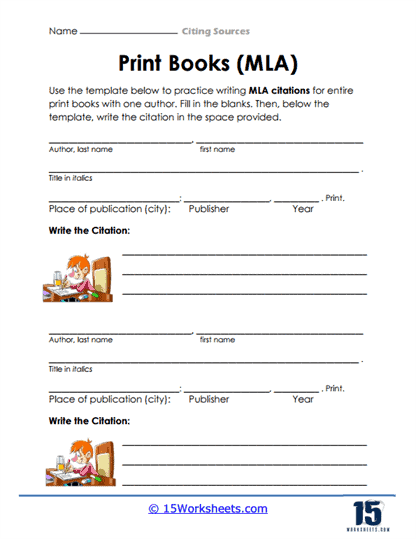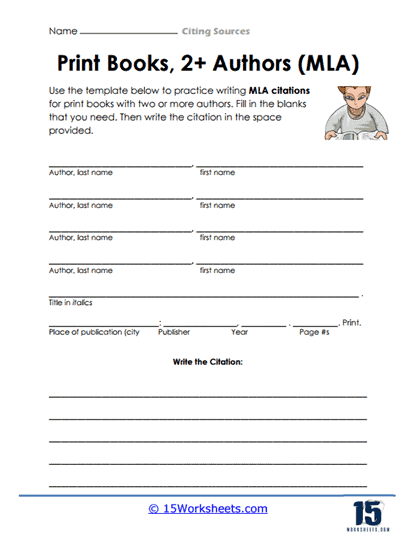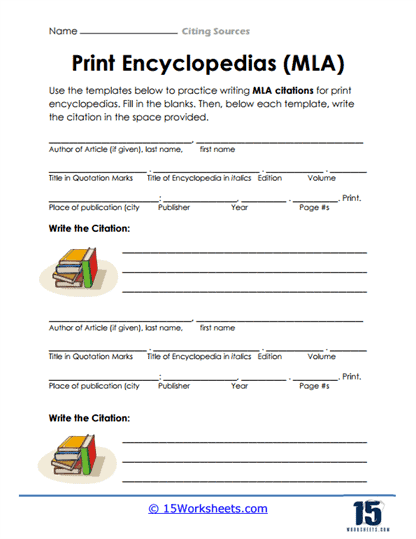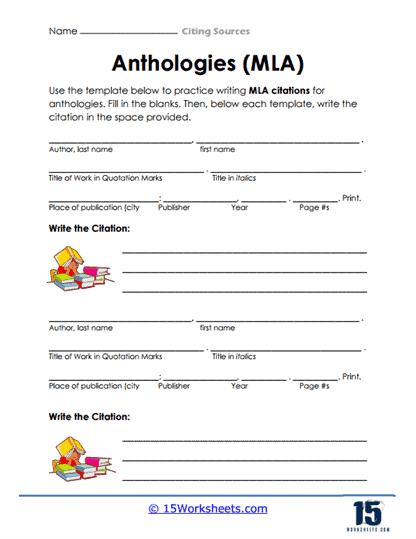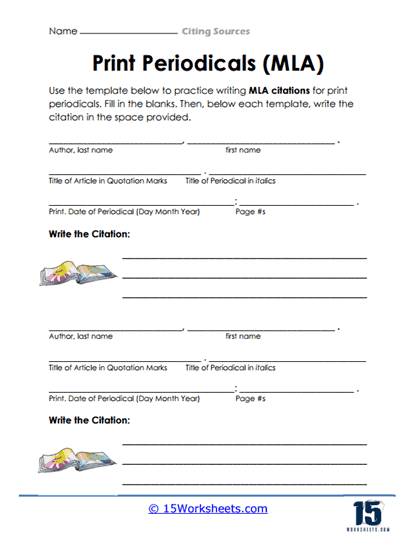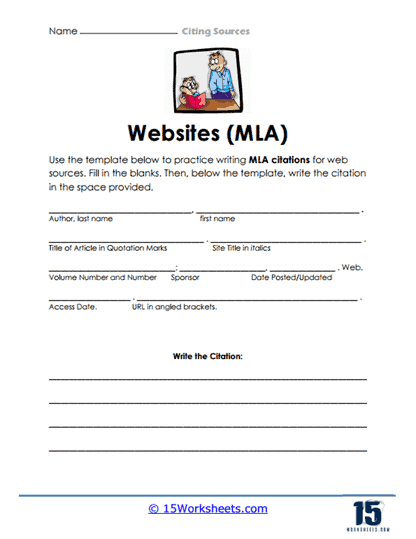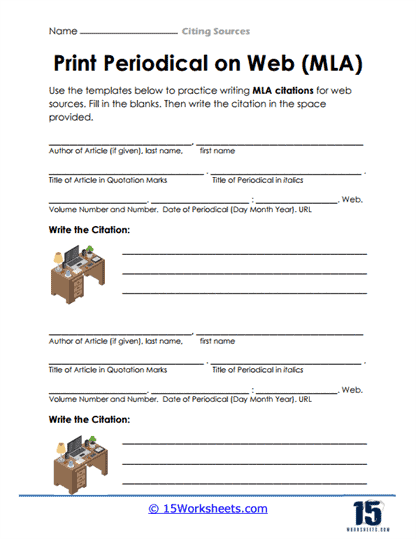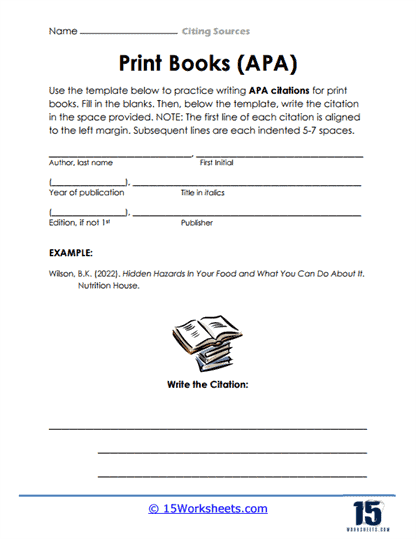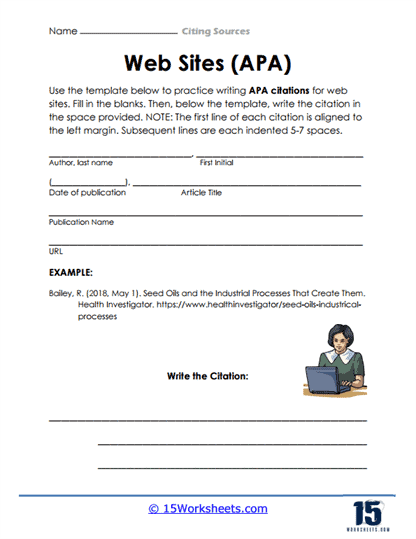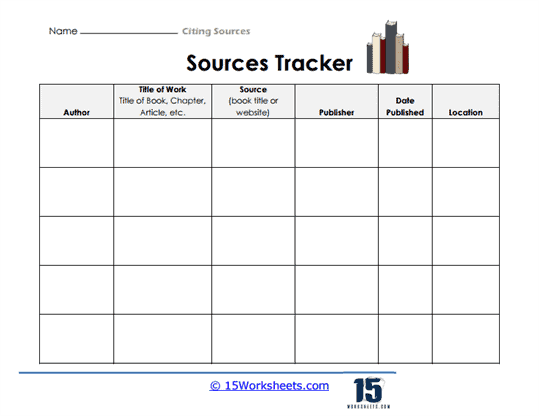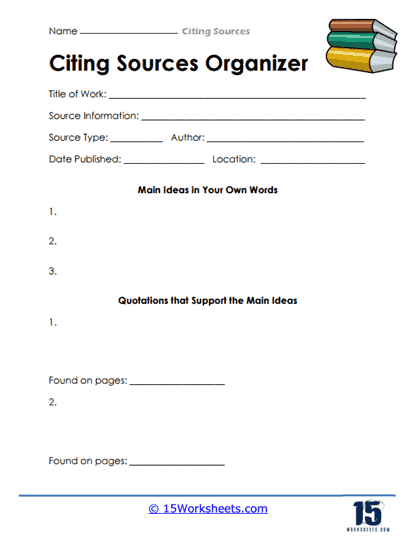Citing Sources Worksheets
All About These 15 Worksheets
Properly citing sources is an essential skill for students engaged in research and academic writing. This series of 15 worksheets has been thoughtfully crafted to guide students through the process of citing sources accurately and adhering to citation style guidelines. Each worksheet focuses on a specific aspect of source citation, providing clear examples and practice exercises to reinforce students’ understanding.
These worksheets cover various common sources, including books, websites, encyclopedias, anthologies, and periodicals, using both MLA and APA citation styles. Students will learn the intricacies of in-text citations, quoting, and referencing, ensuring that their work reflects intellectual honesty and integrity. By engaging with these worksheets, students will develop the necessary skills to attribute ideas and information to their original sources effectively. Through these worksheets, students will:
- Practice incorporating author names and publication years within their writing to properly attribute information;
- Learn how to correctly quote from books within their writing while maintaining proper APA in-text citation;
- Attribute web sources within their written work;
- Hone their knowledge and comprehension of proper citation practices;
- Create proper MLA-style citations for print books, including author names, book titles, publication information, and page numbers;
- Properly format citations for collaborative works;
- Cite print encyclopedia entries in MLA style and explore MLA-style citations for works within anthologies, such as essays or short stories, and print periodicals, such as magazines or journals;
- And organize their sources and track essential information for future reference.
By engaging with these Citing Sources worksheets, students will develop the necessary skills to accurately attribute information, avoid plagiarism, and demonstrate their engagement with relevant sources. Through practice exercises and clear examples, students will gain confidence in citing various types of sources, ensuring academic integrity and effective communication of their research.
Why Do You Want To Cite Sources?
Citing sources is important in writing for several reasons:
Acknowledging Sources
Citing sources is a way of acknowledging the contributions of other authors and researchers whose work has informed and influenced your own writing. It shows respect for the intellectual property of others and helps to establish your credibility as a writer.
Avoiding Plagiarism
Plagiarism is the act of using someone else’s work or ideas without proper attribution. It is a serious academic offense that can result in penalties such as a failing grade or even expulsion from school. Proper citation helps to avoid plagiarism by clearly indicating when you are using someone else’s ideas or words.
Demonstrating Research
Citing sources demonstrates that you have conducted research on the topic and have engaged with a variety of sources to develop your argument or analysis. This helps to establish the validity and reliability of your work and can enhance your credibility as a writer.
Providing Context
Citing sources provides context for your writing by giving readers a sense of the broader conversation or debate surrounding the topic. It allows readers to follow your line of reasoning and to evaluate your argument in light of other perspectives and opinions.
Encouraging Further Research
Citing sources also encourages further research and exploration of the topic by providing readers with a starting point for their own investigation. It demonstrates that your work is part of a larger academic conversation and can inspire others to continue the discussion.
Overall, citing sources is an essential aspect of academic writing that supports intellectual honesty, encourages engagement with a range of perspectives, and helps to establish the credibility of your work.
How Do You Cite Sources in APA Format?
The American Psychological Association (APA) format is a widely used citation style for academic writing in the social sciences. Here are some general guidelines for citing sources in APA format:
In-text Citations
- For a direct quote, include the author’s last name, publication year, and the page number(s) in parentheses. For example: (Smith, 2020, p. 45).
- For a paraphrase or summary, include the author’s last name and publication year. For example: (Smith, 2020).
- For multiple authors, use an ampersand (&) between the last two authors’ names. For example: (Smith & Johnson, 2020).
- For three or more authors, list the first author’s last name followed by “et al.” For example: (Smith et al., 2020).
Reference List
- Start the reference list on a new page at the end of your paper.
- Title the page “References” (centered, bold, and without quotation marks).
- List your sources alphabetically by the author’s last name.
- Use a hanging indent for each reference (first line flush left, subsequent lines indented).
Here are examples of common reference types:
Books: Author, A. A. (Year of publication). Title of work: Capitalize the first letter of the first word and any subtitles. Publisher.
Example: Smith, J. D. (2020). The art of citation: A comprehensive guide. Academic Press.
Journal Articles: Author, A. A. (Year of publication). Title of article: Capitalize the first letter of the first word and any subtitles.
Title of Journal, volume number(issue number), page range. DOI or URL (if available)
Example: Johnson, M. K., & Smith, R. L. (2021). The impact of social media on mental health. Journal of Psychological Studies, 15(2), 45-60. https://doi.org/10.1111/jps.12345
Websites: Author, A. A. (Year, Month Day of publication). Title of webpage: Capitalize the first letter of the first word and any subtitles. Website name. URL
Example: Green, L. (2021, April 30). The role of technology in modern education. Tech Today. https://www.techtoday.com/role-technology-education
These are general guidelines for citing sources in APA format. Be sure to consult the APA Publication Manual or an online guide for specific rules and examples, as there may be variations for different source types or situations.
How Do You Cite Sources In MLA Format?
The Modern Language Association (MLA) format is a commonly used citation style for academic writing in the humanities. Here are some general guidelines for citing sources in MLA format:
In-text Citations
- For a direct quote, include the author’s last name and the page number(s) in parentheses. For example: (Smith 45).
- For a paraphrase or summary, include the author’s last name and the page number(s). For example: (Smith 45).
- For multiple authors, list both authors’ last names separated by “and”. For example: (Smith and Johnson 78).
- For three or more authors, list the first author’s last name followed by “et al.” For example: (Smith et al. 112).
Works Cited List
- Start the Works Cited list on a new page at the end of your paper.
- Title the page “Works Cited” (centered, without bold, italics, or quotation marks).
- List your sources alphabetically by the author’s last name.
- Use a hanging indent for each entry (first line flush left, subsequent lines indented).
Here are examples of common reference types:
Books: Author’s Last Name, First Name. Title of the Book: Capitalize the First Letter of the First Word and Any Subtitles. Publisher, Year of Publication.
Example: Smith, John D. The Art of Citation: A Comprehensive Guide. Academic Press, 2020.
Journal Articles: Author’s Last Name, First Name. “Title of Article: Capitalize the First Letter of the First Word and Any Subtitles.” Title of Journal, volume number, issue number, Year of Publication, page range.
Example: Johnson, Mary K., and Robert L. Smith. “The Impact of Social Media on Mental Health.” Journal of Psychological Studies, vol. 15, no. 2, 2021, pp. 45-60.
Websites: Author’s Last Name, First Name (if available). “Title of Webpage: Capitalize the First Letter of the First Word and Any Subtitles.” Website Name, Date of Publication (if available), URL.
Example: Green, Laura. “The Role of Technology in Modern Education.” Tech Today, 30 April 2021, www.techtoday.com/role-technology-education.
These are general guidelines for citing sources in MLA format. Be sure to consult the MLA Handbook or an online guide for specific rules and examples, as there may be variations for different source types or situations.

